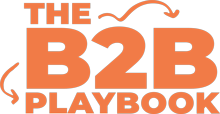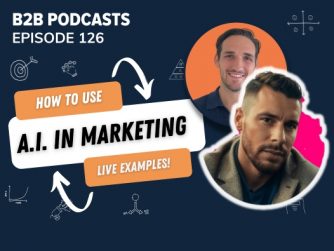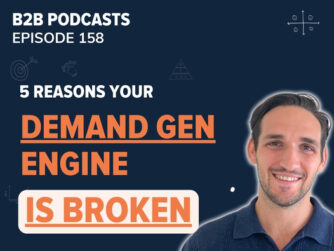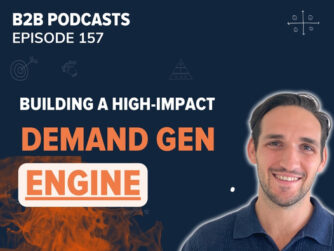Want to know how we ranked for a competitive keyword in just 67 days? No gimmicks, no hacks – just a solid SEO strategy that anyone can implement.
Today, I’m going to walk you through exactly how we did it. We took a high-intent keyword that brings in serious buyers and raced past some of the biggest names in B2B. And the best part? The traffic we generated wasn’t just numbers—it was high-quality leads that turned into deals.

We partnered with B2B SEO expert Sam Dunning, who last episode gave us the ‘blue print’ to follow on how to rank #1 (you can see that here). I then went and executed this strategy consistently to see how long it would take to reach top spot!
Keep reading, and you’ll get the step-by-step breakdown of how we identified the right keyword, optimized our landing page, and built strategic backlinks to secure that coveted #1 spot. I’ve shared everything – so let’s hope the competition doesn’t see this 😂.
As per usual, you can read, watch or listen to the advice given and how we executed it below.
Listen To The Episode
Watch The Episode
Defining Our SEO Goal: Rank for a “Money Keyword”
When it comes to SEO, not all keywords are created equal. Sure, you can chase high-traffic keywords, but the real gold lies in the ones that bring buyers to your doorstep. That’s why we set our sights on what we call a “money keyword” for our business—demand generation course.

This wasn’t a random choice. We knew this keyword had high intent, meaning that people searching for it were likely serious about investing in a solution. It wasn’t just about traffic for the sake of traffic. As Sam pointed out, demand generation course had 100-200 searches per month, and those searches were growing by 90% year-on-year. That’s a clear signal that more and more people are moving toward demand generation as a strategy, and they’re actively seeking out courses like ours to learn how to implement it.
The beauty of a keyword like this is that it aligns perfectly with our offer: a 12-week program designed to teach B2B marketers how to implement demand generation in their businesses. So, the people searching for this term? They’re already in the market, they’re ready to learn, and they’re ready to buy. We weren’t just chasing rankings; we were targeting the exact audience that would turn into leads and, eventually, customers.
Proof of SEO Results
It took 67 days, but we got to no.1 spot executing Sam’s strategy. In doing so, we went past some pretty huge, well established competitors to nab top spot.

You can see below in our screenshot of Google Analytics when we first created the page, and when we hit the no.1 spot.

Pretty awesome considering it was a brand new, fresh page! Also you see from last episode with Sam that we have a pretty low Domain Authority (DA) – so if you’re a newer brand, this strategy can still work for you.
Keyword Research and Competitor Analysis
Finding the right keyword isn’t just about search volume—it’s about intent. When Sam did the initial keyword research, we found a few terms that looked promising, but most of them didn’t make sense for us to target. Either the search volume wasn’t there, or Google was favouring long-form “how-to” articles that didn’t align with our goal of driving conversions. We needed a keyword that attracted people ready to buy, not just browse.
That’s how we landed on demand generation course. This keyword had the right kind of search intent—people who are looking for a course are usually much further down the funnel. They’re actively seeking a solution and ready to engage in a sales conversation. That’s where we saw the opportunity. We weren’t just competing for clicks – we were targeting people who were ready to make a decision.
Sam encouraged us to not just stop at keyword selection. We dove deep into competitor analysis. There were big names already ranking for demand generation course—companies like Cognism, CXL, and Pavilion. These guys had high domain authority, so we knew we’d be up against tough competition. Fortunately, Sam spotted some weaknesses in their pages: they weren’t as specific or actionable as ours. They were mostly generic course listings or long-form content, which left gaps we could exploit. We weren’t just going to match them—we were going to surpass them by creating a page that laser-focused on addressing the real pain points of our audience.
That’s how we leapfrogged some of the biggest names in the industry. It wasn’t about doing more, it was about doing better.
Landing Page Optimization
When it comes to ranking, you can’t just throw up any old landing page and hope for the best. It needs to be optimized—both for Google and for your audience. We started with the basics. Our original H1 was something like, “Build Your Demand Gen Engine in 12 Weeks.” Good, but not great. It didn’t hit the exact keyword we were going after: demand generation course. So, we changed it to something that would not only rank but grab attention: The Ultimate Demand Generation Course – Crush Your Revenue Targets in 2024. That way, it was crystal clear what we were offering, and it had a bit of a punch to it.
Next up, we tackled the meta title and description. Sam advised us to be really direct here. We went with “Demand Generation Course | Crush 2024 Revenue Goals,” putting the keyword front and centre while making the promise of real results. And in the meta description, we didn’t just throw in the keyword—we made it actionable: “This 12-week course gives you the strategy, templates, and tools to deliver a best-in-class B2B demand generation program”. We knew this would give us a better shot at getting people to click because the page instantly promised exactly what they were looking for.

But ranking isn’t just about ticking off SEO boxes—it’s about delivering value once people land on the page. So we didn’t stop with just the basics. We beefed up the content by addressing the specific pain points of our audience: What are they struggling with in demand generation? How does this course solve those problems? We packed the page with real examples, case studies, and testimonials from B2B marketers who’d already taken the course and seen results.
Another big move was adding a dedicated section for reviews of the course. Instead of just saying, “Here’s why you should take our course,” we let our customers speak for us. We even optimized that section with an H2 heading: “Reviews of Our Demand Gen Course from B2B Marketers”. And for the FAQs, we didn’t settle for generic. We made sure each question included the keyword demand generation course and tackled the real concerns prospects had.
Lastly, rather than tweaking our existing B2B Incubator page, we built a brand-new page dedicated to this keyword. That allowed us to focus all our SEO efforts on this one goal. We created the page on June 2nd, and by August 8th—just 67 days later—we hit number one!
Executing a Strong Internal Linking Strategy
Internal linking might not be the sexiest part of SEO, but it’s one of the most effective—and easiest—things you can do to boost your rankings. So why is internal linking important? When you create a new page, Google needs a way to find and understand it. And the fastest way to make that happen? Internal links. Sam explained this perfectly:
“Internal linking is just a simple way to make it super easy for Google to find and crawl your new page”.
Sam Dunning – The B2B Playbook
So we made sure to link back to our demand generation course page from several existing articles on our site.

Now, we didn’t just drop links anywhere. We targeted our high-traffic, relevant pieces—like How to Measure Demand Generation KPIs and The Ultimate B2B Demand Generation Guide—and naturally worked in links to the course page. We did our best to connect related content that made sense for both Google and our readers. Google sees that these pages are interconnected, and it boosts the relevance of our course page in the process.
We also took the time to optimize our anchor text. We didn’t just link the words “click here” or “learn more.” Every internal link used phrases like Demand Gen Course or Join Our 12-Week Demand Gen Course (00:24:10). This helps Google understand exactly what the page is about and gives us an extra boost in relevance for that keyword.
To stay organized, we kept a simple spreadsheet (pictured above) tracking every internal link we created—what anchor text we used, where we placed the link in the article, and how it connected back to the new landing page. That way, if something went wrong or our rankings stalled, we could look back and see if there was a pattern we needed to tweak. Internal linking may be basic, but when done right, it builds domain relevance, helps Google crawl faster, and makes it easier for users to navigate your site. Simple, effective, and it works.
Building Backlinks with Minimal Effort
Backlinking doesn’t have to be a grind. In fact, some of the best backlinks come from the relationships you’ve already built. Sam gave me a great strategy: make a list of partners, clients, and even friends who serve a similar audience but aren’t direct competitors. These are the people who are already in your network and would be more than happy to collaborate on content that includes a backlink to your site.

Take Justin Rowe from Impactable, for example. We’ve been on each other’s podcasts, and we’ve built a solid relationship. So when I reached out and asked if we could collaborate on content that would naturally link back to our demand generation course, it was an easy win. I ended up writing a guest article for his site about how LinkedIn Ads can fuel demand generation, and of course, we included a backlink to the course page. It was a simple ask, but incredibly effective.
This strategy worked with other partners, too. I reached out to Factors.ai, a big SaaS player in our space, and offered to write a guide on how their software can be used in demand generation. They loved the idea, published the content, and we got a high-authority backlink from their site. It was a win-win—quality content for them, and a powerful link for us.
Securing those higher-authority links from companies like Factors.ai was what pushed us from the bottom of page one to the top spot.
We also went back to other companies that had me on their podcast previously, and requested that they update the page where the podcast was hosted to include a backlink to our page we were trying to rank.
And of course, we tracked everything. I kept a spreadsheet of all the backlinks we secured, the anchor text we used, and when they went live. That way, we knew exactly how much progress we were making. In just a week, we had three or four backlinks secured, simply by leveraging existing relationships. No cold outreach, no heavy lifting—just smart, strategic partnerships that worked for both sides.
Tracking and Analysing Results
You can’t improve what you don’t track, and that’s why we closely monitored everything from day one. Over 67 days, we had around 120 sessions on our demand generation course page. Not massive traffic, but here’s the kicker—those sessions were incredibly targeted. From that traffic, we generated eight deals in the pipeline, and one closed almost immediately. The quality of the traffic was more important than the quantity. As Sam pointed out, when the people landing on your page are the right people, they convert. It’s that simple.
We really saw the shift once we hit the top three rankings. That’s when the pipeline started filling up fast. But hitting that #1 spot? That’s where the magic happened. Not only did we see more people coming in, but the leads were even more qualified. It’s not just about being on the first page—it’s about dominating the top of it.

The bottom-line outcome? We had 8 deals come through in the pipeline and closed 1 of them. The other 8 are very high quality and are a good chance at closing at some point in the future.
This was an unreal outcome, very quickly – and is why we often encourage B2B marketers to tackle the Demand Gen content strategy from the ‘bottom up’. The keywords we targeted matched our ICP very nicely, which is why the intent and conversion rate is likely to be high.
Key Takeaways and Next Steps
SEO isn’t just about ranking high for the sake of it—it’s about bringing in the right people who are ready to take action. Over 67 days, we went from zero to the #1 spot for a competitive keyword, and the results speak for themselves: a strong pipeline, eight deals, and one already closed. It wasn’t about getting thousands of visitors, it was about getting the right ones.
The takeaway here is simple: focus on the keywords that matter to your business, optimize your landing pages to solve real problems, and build backlinks through relationships you’ve already got. Do that, and you’ll not only see traffic—you’ll see revenue. We tracked every step, analysed what worked, and made sure our efforts were targeted toward high-quality traffic, not just numbers on a screen.
Just like Demand Generation, the key to success in SEO is consistency. Ranking number one is great, but keeping that spot means you need to keep building links, updating your page, and continuing to deliver value. The work doesn’t stop when you hit the top—it’s just the beginning. So, take these steps, implement them for your own business, and watch the results roll in.
Now, it’s your turn. Ready to rank your money keyword? Start implementing these strategies today, and soon you’ll be seeing results that matter. Let’s crush it.








